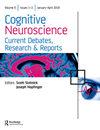Feeling & knowing: Making minds conscious.
IF 2
4区 医学
Q3 NEUROSCIENCES
Cognitive Neuroscience
Pub Date : 2021-01-01
Epub Date: 2020-12-15
DOI:10.1080/17588928.2020.1846027
引用次数: 28
Abstract
(1) Let me begin by thanking Doerig et al. for including my work in their survey of empirical theories of consciousness (although I am a bit spooked by being assigned the number 13!), especially given the authors’ concern for the large number of currently competing theories. I also appreciate their idea that the reason for this abundance may be a lack of stringent selection criteria although I suggest that the problem actually begins prior to the selection of proposals: it concerns the clarification of what exactly is the point of these studies. This is not a new problem. I recall spending many hours, most of them pleasant, discussing this very issue with some of the most distinguished contributors to the field ― Gerald Edelman, Giulio Tononi, Francis Crick, Christof Koch, Stanislas Dehaene, Jean Pierre Changeux, David Chalmers, Stuart Hameroff, Roger Penrose ― but no clear agreement ever emerged as to what the exact phenomenon was that we were so devoted to understanding. My position, then and now, is that the approach to consciousness must begin with introspection. We can inspect our mental processes and decide, on the basis of their psychological analysis, what the phenomenon of interest is. Subsequently, we can use facts drawn from physics, chemistry, biology, and neuroscience to build hypotheses regarding the mechanisms behind the phenomenon. (2) Introspection tells me that consciousness consists of an enrichment of the basic process of mind. Minds are made of flowing, representational, imagetic patterns based on varied sensory mappings, primarily related to perception and memory recall. The flow of images is not ‘conscious,’ per se, but can be rendered conscious by adding to it knowledge to the effect that the ongoing mental contents belong to a particular organism. (3) The above transformation is first accomplished by feelings. Feelings are hybrid processes, based largely on the body’s interior and carried out, physiologically, as an interaction between (i) homeostatically driven, life-regulatory routines occurring in the chemical-visceral interior, and (ii) interoceptive maps generated at multiple peripheral levels (e.g., spinal ganglia; trigeminal ganglion) and central nervous system (e.g., brainstem nuclei; insular cortices; cingulate cortices). Whereas exteroception accomplishes the mapping of external objects and actions that are strictly separate from the perceiving organism, interoception accomplishes the mapping of internal organism events. As a result, an interaction between ‘object of perception’ and ‘subject’ is maintained throughout the process and results in a unique hybrid. Moreover, the anatomical and physiological features of interoception are also unique. The critical step in the generation of consciousness, then, is the revelation, made within the mind, that the mind belongs to and is located within a specific living organism. This revelation is firstly accomplished by feeling but is complemented by (a) proprioceptive signals arising from the musculoskeletal frame, by (b) exteroceptive signals which define organism perspective in coordinate space, and by (c) recall of memorized material related to critical aspects of the organism’s history. (4) Doerig et al. have kindly used SCTM to designate my proposal (this is the acronym for Self Comes to Mind, the title of my 2010 book on consciousness). However, I have never given its theoretical treatment any specific name and although the foundations of my current thinking on consciousness have not changed, the details of the account have. For example, I no longer believe that specifying varied levels of ‘self process’ is of any help, on the contrary, it confuses matters.感觉和认知:使头脑有意识。
本文章由计算机程序翻译,如有差异,请以英文原文为准。
求助全文
约1分钟内获得全文
求助全文
来源期刊

Cognitive Neuroscience
NEUROSCIENCES-
CiteScore
3.60
自引率
0.00%
发文量
27
审稿时长
>12 weeks
期刊介绍:
Cognitive Neuroscience publishes high quality discussion papers and empirical papers on any topic in the field of cognitive neuroscience including perception, attention, memory, language, action, social cognition, and executive function. The journal covers findings based on a variety of techniques such as fMRI, ERPs, MEG, TMS, and focal lesion studies. Contributions that employ or discuss multiple techniques to shed light on the spatial-temporal brain mechanisms underlying a cognitive process are encouraged.
 求助内容:
求助内容: 应助结果提醒方式:
应助结果提醒方式:


